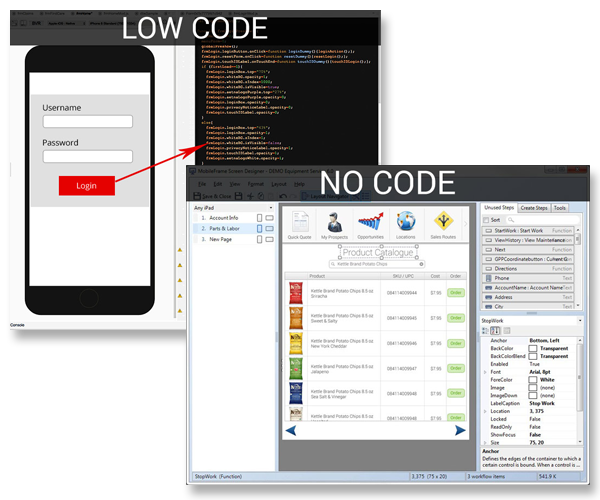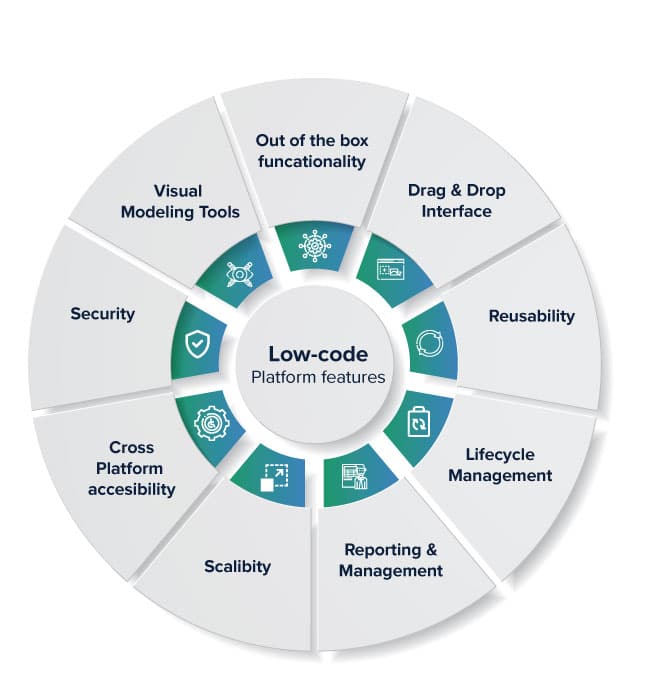Best Tips To Picking Low-Code Platform Examples
Best Tips To Picking Low-Code Platform Examples
Blog Article
The Benefits Of Low-Code Development To Speed Up Development
Visual Development Environment (VDE):
Drag-and-Drop Interfaces: Low-code platforms provide visual tools for designing applications. Developers can build applications using drag-and-drop components without writing code.
Many low-code platform come with pre-built templates and components. This allows developers to quickly build or prototype applications without starting with a blank slate.
Reduction of Coding Requirements
Automated Code Generation Low-code platforms automatically generate the code that is used to build the visual models created by programmers. This reduces the requirement to manually code and speeds up development.
Reusable Components: Developers are able to use reusable components across different projects, which reduces the amount of time that is spent writing and testing code.
Collaboration can be made easier.
Low-code platform tools often contain versions control, testing or deployment. This allows for seamless collaboration between teams.
Citizen Development: Non-developers and business users can utilize user-friendly interfaces to aid in the development of applications which reduces bottlenecks caused by a shortage of professional developers.
Rapid Iteration, Prototyping:
Fast Prototyping Developers can quickly develop prototypes to allow ideas to be validated and feedback gathered which results in faster iteration.
Easy Modifications. The visual nature that low-code development gives makes it simple to modify and update applications. This speed up the process of improving and refining the application by incorporating the feedback of users.
Pre-built Integrations:
API Integrations. A number of low-code platforms offer connectors designed for the most popular APIs and services. This could speed up the process of integrating systems.
Data Integration: The instruments built within the software ease and accelerate the process of connecting databases, other applications and data sources.
Deployment of Scaling:
One-Click Deployment: A lot of low-code platforms offer one-click deployment options, significantly cutting down on the time and effort needed to deploy software.
Cloud-Based Solutions: Cloud-based low-code platforms can manage scaling and infrastructure management, allowing developers to focus on the logic of their applications and functions instead of the logistics of deployment.
All in all, low-code development offers advantages in terms of speed due to its ability of automatizing and simplifying a variety of elements of development. This allows for faster app delivery and a simpler adaptation to changing needs. View the top rated Low-code Platform for application development for more recommendations including no code platforms, push alerts, application modernisation, rapid application design, develop mobile application, application development platforms, rad application development, rad application development, driver jdbc, azure sql databases and more.
The Benefits Of Low-Code Development In Terms Of Flexibility, Scalability And Scalability
Low-code app development provides several advantages, including scaling and a flexible design for the application. These are essential to create applications that respond to changing requirements and grow with the business. Here are the key advantages: Rapid Scaling
Cloud-based deployment: Many lowcode platforms are based on cloud computing, which allows applications to grow with the underlying infrastructure. This allows businesses to manage growing demands without having to worry about the management of servers.
Auto-Scaling Feature: Built-in features that automatically scale resources in order to meet demand can ensure consistent performance with no manual inputs in peak hours.
Flexible Architecture:
Modular Application Design: A low-code platform encourages modular design of applications. Components are able to be independently tested, developed and expanded. Modularity improves flexibility and makes it easier to expand or update specific elements of a program without affecting the overall system.
Microservices Architecture: The Microservices architecture supports the creation of applications using a loosely coupled set of services. This improves scalability & flexibility.
Customizable Solutions:
Extensibility: Low code platforms typically allow customization of scripts and codes, which allows developers to expand the functionality of applications beyond the ones that are available. This allows unique business requirements to be fulfilled without limitations.
Third-Party Integrations: The incorporation of APIs, third-party services or other services enables businesses to increase the capabilities of their application by adding additional functionalities.
Agile Development and Deployment
Continuous Delivery and Deployment Low-code Platforms facilitate agile methods through enabling continuous integration and Continuous Delivery (CI/CD). This allows rapid delivery of updates and new features, which allows applications to evolve quickly as a result of the feedback of users and changes in the market.
Iterative Development: The iterative nature of low-code development implies applications are able to be improved incrementally and expanded, reducing risk associated with large-scale changes and allows for more controlled growth.
Resource Optimization
Efficient Resource Management: Low-code systems assist maximize the use of resources by offering instruments for monitoring and controlling the performance of applications. This helps ensure that resources are utilized effectively and can be scaled to meet the actual demands.
Load Balancing : The integrated load balancing function distributes workloads equally across servers. This enhances the application's capacity to handle high traffic, and ensures the same performance.
Global Reach
Multi-Region Deployment: Low-code systems generally support deployment across multiple geographical regions, allowing businesses to provide low-latency access to users around the world. This is crucial when it comes to applications that target a global audience.
Support for Localization: The built-in support of localization lets the software be easily customized to suit different languages and the requirements of diverse markets.
Maintenance and updates
Simplified Maintenance: The visual and modular design of low-code programs makes maintenance easier, allowing bugs and updates to be made quickly, without a long period of downtime.
Version Control System for Version Control: These integrated versions handle rollbacks and changes in order to make sure that upgrades can safely be made and that older versions can restored if necessary.
Cost Efficiency:
Low Development Costs - Through reducing the amount of coding needed, low-code platforms can lower the development cost. This makes it possible to scale up applications without having to increase the development effort and expenditure.
Pay-As-You-Go Models - A lot of low-code platforms offer flexible pricing models, such as pay-as you-go that adjusts prices to the actual usage, growth, as well as financial flexibility.
In general, low-code development offers businesses the flexibility and scalability they need to build robust and flexible applications. These platforms permit quick changes to the demands of changing times and efficient use of resources and continuous improvement, ensuring that applications can develop and grow with the business. Check out the best helpful site on Enterprise application development with Low-code Platform for website tips including cross platform app development, app modernization, azure sql, application modernization, software for app development, mobile app development platforms, driver jdbc, push alerts, app modernization, develop web app and more.
Benefits Of Low-Code Application Development In Terms Of Community Support And Vendor Support
Low-code platforms provide significant benefits in terms of community support and vendor support and vendor support, both of which are essential for success in the implementation, maintenance and improvement of applications. Here are the major benefits:Vendor support
Comprehensive Technical Support:
Support Team with Dedicated Staff: Many low-code platforms have a dedicated support personnel who can assist with technical issues or troubleshooting issues, as well as providing advice. They will ensure that issues are addressed quickly.
Some vendors offer 24/7 support. This is advantageous for companies operating across time zones.
Training and Onboarding:
Vendors often provide structured programs for users, such as tutorials and webinars. They can also offer certificates.
Personalized onboarding: Many vendors have customized services for customers who are new helping them to set up the platform in a proper manner and adapt it to their requirements.
Regular Updates and enhancements:
Continuous improvement: Low-code platforms typically release regular updates which include new features, performance enhancements and security patches ensuring that the platform stays modern and safe.
Feedback Integration: Many vendors integrate user feedback into their development cycles. This helps ensure that the platform is able to adapt to the ever-changing demands and needs of its users.
Comprehensive Documentation:
Documentation - Comprehensive Documentation: A complete and well-organized document covering everything from basic use to advanced customizations, is often available. This allows users to solve issues on their own.
API References API documentation can aid developers build and integrate apps using the Low-Code platform.
Professional Consulting Services
Expert Consulting: Vendors typically provide consulting services that assist with planning for strategic purposes as well as design of architecture and complex implementations, ensuring that users can leverage the platform to its maximum potential.
Custom Development Services Some companies offer custom development services to create specific functions and integrations that are not included in standard.
Community Support
Active User Communities:
Discussion boards and forums: Many low code platforms offer vibrant online communities that let users ask questions, exchange solutions and work together on best practices.
Local and virtual user groups as well as Meetups provide the opportunity for users to share their experiences, share their knowledge with others, and network.
Knowledge Sharing & Collaboration:
Community-Contributed Resources: Users often share templates, modules, and extensions that they have developed, which can be reused or adapted by others, accelerating development and innovation.
Crowdsourced Problem-Solving: The collective wisdom and experience of a group can be a valuable source to solve problems and discover creative solutions to complex problems.
Learning and Development
Community-Led Training: Many communities host workshops, training sessions, and webinars, often run by knowledgeable users who provide practical insights and more advanced methods.
Online Tutorials and Courses: The community members frequently publish online tutorials, courses, and tutorials on how to do things, which enhances learning resources.
Feedback and Influence
Product Feedback: Several community forums offer channels to give feedback to vendors. This can influence the design of new features or improvements.
Beta Testing Programs: Members of the community who are active may have the opportunity to take part in beta testing programs that give the opportunity to test new features and a voice in shaping the platform's evolution.
Recognition and Support
Community Recognition Programmes: Many companies offer recognition programs to active members of the community. Some examples include MVP (Most Valuable Professionals) which acknowledges their contributions.
Peer Support. Community members provide peer support. They share their knowledge with users who are less familiar and provide guidance. This creates a community that is supportive and collaborative.
Overall, the combination of a strong vendor's support and a lively, active community offer a robust support system for low-code development. Users will have the ability to access the resources, experts and collaboration opportunities that they need in order to successfully build, deploy, maintain and improve their applications.